
In the mid-1970s North Indiana 5-piece MAGI ruled the "Michiana" region with a tight, raw hardrock sound that drew huge crowds wherever they played. The band is known today mostly for the rare "Win Or Lose" LP which changes hands for 100s of dollars, but the album is just a small piece in the band's story. |
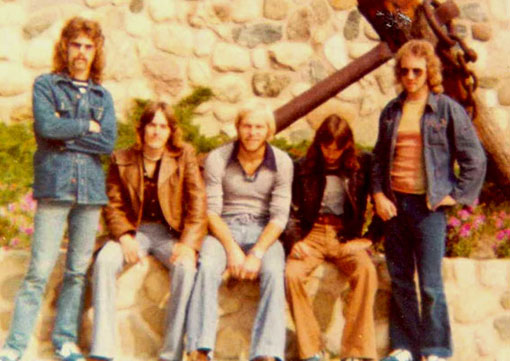 |
I was
recently fortunate to connect
with bass player Tom Stevens for what is
probably the first ever retrospective of MAGI who better than most signify
that special Midwestern phenomena, the huge regional band.
After our initial contact I realized that I had actually met Tom in real
life back in 1987, when visiting backstage with the band that he's most
famous for today, 1980s legends the LONG RYDERS.
The Ryders story has been covered in detail elsewhere, but Tom provided some
interesting data on his transition period from Magi into the Ryders and
a solo mini-LP he did in 1983, as well as a snapshot of the LA
scene at the time.
Apart from these peeks into two very different eras, Tom also dug up some
rare graphics and a few never before seen photos. At the end of
the interview MAGI's recordings are detailed, including a number of
unreleased tapes that Tom and I agree surpass the "Win Or Lose" LP
in quality.
Q: What was the teen music/rock scene like in Indiana in the mid-1970s? What major bands and styles were the most influential?
TOM: The
last of the local rock and roll "teen dance" scene that started in
the early 60s was still alive in the mid-70s. The YMCA-YWCA in
Elkhart, Indiana would have dances on Saturday nights, a place called The
Electric Circuit in downtown Elkhart (they had walls painted black with
day-glo paintings) had bands Friday nights, and every High School (and
some Junior High Schools) would have their dances as well. Also, the legal
age for alcohol was 18 in Michigan, just a few miles north, so there were
lots of bars that had bands, sometimes 6-7 nights each week. That entire
scene died by the early 80s, when schools stopped bands and started DJs, and
the drinking age in Michigan went to 21.
There were basically three schools of rock bands here in the
mid-70s:
1) Pop, or what we called Top 40 bands, that played cover songs that
were hits of the day. South Shore was one of the most popular bands of that
genre in the area, and they released a 45 called "Do Me
Right" that received lots of local airplay on WRBR-FM, and I think they
made other 45s, but no LPs. These top 40 bands were possibly the most
direct offshoot of the local Fujimo 60s bands like The Tempests and Dukes,
but most didn't write their own material or make
records.
2) Hard rock bands, influenced by Aerosmith, Alice Cooper, Kiss, Foghat.
Magi fell into that category. Kopperfield was another
local band in that era that's listed in Fuzz, Acid & Flowers for
their album "Tales Untold". Kopperfield crossed the hard
rock and progressive genres. I saw them more than once live during that
time and I remember thinking they were a very good live act for their style.
"Tales Untold" was recorded at Uncle Dirty's Sound Machine in
Kalamazoo, Michigan, about 45 miles north of Elkhart, Indiana and the
same studio Magi recorded "Win or Lose". It didn't
really reflect Kopperfield's powerful stage sound, just as Magi's
LP didn't.
3) Progressive rock bands. Most popular was Ethos from Fort Wayne,
Indiana, and they played here a lot. Ethos was firmly in
the Yes/Genesis/King Crimson mold, and they later made LPs
for Capitol. They were called Atlantis before signing to Capitol.
Q:
Did Magi already exist when you joined? What were the circumstances behind
you joining the band?
TOM: Magi formed in 1973. The original drummer was Jim Kauffman, who was
replaced by Jerry Wiggins in 1974. They already had made a demo with
original songs with their original bassist, Larry Hertzler. Hertzler
graduated high school the same year I did (1975) and he was leaving to
college. I had scholarship offers from several universities to study string
bass, but turned them all down. I wanted to play rock and roll music
and the thought of either playing in a symphony orchestra or teaching music
in a high school did not appeal. My first Magi gig was a large outdoor party
in Elkhart, Indiana on July 4, 1975, followed shortly after by
a concert at a small auditorium in Topeka, Indiana. I met Larry
Stutzman, one of the Magi lead guitarists, in about 1974 when he started
working for Harmony House of Music in the Pierre Moran Mall in Elkhart,
Indiana. I was teaching guitar and bass there (I started teaching when I was
16) and Larry and I became good friends. I went to see Magi for the first
time in early 1975 at a high school dance. I also joined since the
band I was in (Freedom, a top 40 band, no originals/recordings) was breaking
up due to members leaving for college.
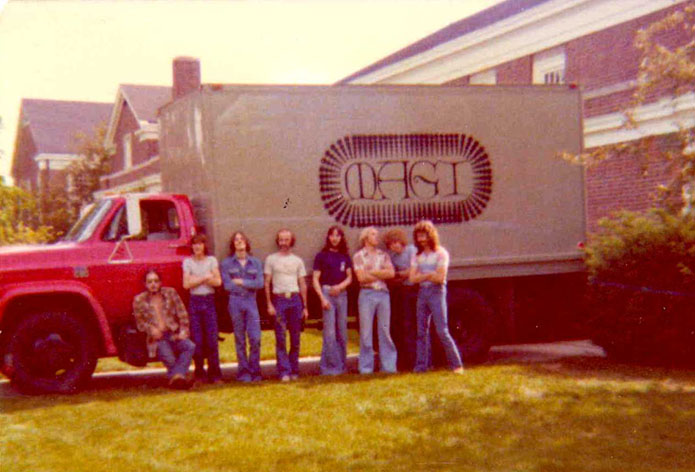
"L-R:
Jeff Copsey (road crew, RIP), unidentified
road crew member, Tom Stevens, Rick Ellis
(road crew), Jerry Wiggins, Steve Vanlaningham, 'Buffalo
Chip' (road crew), John
Gaut.
Not pictured: Larry Stutzman (probably who took the picture)."
Q: Could you say something about the background of the
other Magi guys -- was it all local guys? Had anyone of them played in any
bands that made recordings, that you know of?
TOM: All
Magi members were from nearby small towns in Northern Indiana - Larry
Stutzman was from Goshen, John Gaut from Nappanee, Jerry Wiggins from
Wakarusa and Stave Vanlaningham (correct spelling) was from Milford. No one
had any records out previously, that I know of, and we were all in our teens
when we started in the band. Larry Stutzman was in an Alice
Cooper-influenced band called Skull before Magi, his father was in a Hank
Williams-type band called Little Joe and the Blue Jays in the 1950s (no
released records but I have a great tape of them), and his uncle was Danny
Lee, who pioneered the Contemporary Christian genre in the early 1970s. One
of his LPs was nominated for a Grammy in 1972, losing to Elvis. He made
records for RCA and at least one other label.
Q: I understand Magi were quite popular in the area. Do you remember other
local bands of the time that you competed with?
TOM: We did play outdoor festivals in the summer with other local bands -
E.J. Hawkins, Fuse, Sky, Loose Talk. I don't think any of those bands
made records.
Q: The Magi LP is all originals I believe. Did the
band play any covers that you recall?
TOM: Yes, the "Win or Lose" LP was all originals. Aerosmith,
Foghat, Blue Oyster Cult, Beatles and Kiss were among the bands we
covered at dances when we had to play 3-5 hour shows, but the
concerts were almost all original songs once we had enough
material. Taken from an audience tape of the first gig I played with
Magi in July 1975 at Topeka, Indiana, here’s the set list for the nearly
two-hour show:
Daytripper > (The Beatles)
Win or Lose (Magi)
Humpty's Blues > (Guess Who)
Walkin' the Dog (Aerosmith)
Undecided Man (Magi)
Space Station #5 (Montrose)
Runnin' Low (Magi)
Adam's Apple (Aerosmith)
Steve's Jam (Magi)
Make It (Aerosmith)
Stone Cold Crazy (Queen)
Hard Times (Magi)
Larry Stutzman guitar solo >
Train Kept-A-Rollin' (Aerosmith)
Eight Days on the Road (Foghat)
Same Old Song and Dance (Aerosmith)
Good Rockin' Tonight (Montrose)
What You're Doing (Rush)
Dominance and Submission (Blue Oyster Cult)
Toys in the Attic (Aerosmith)
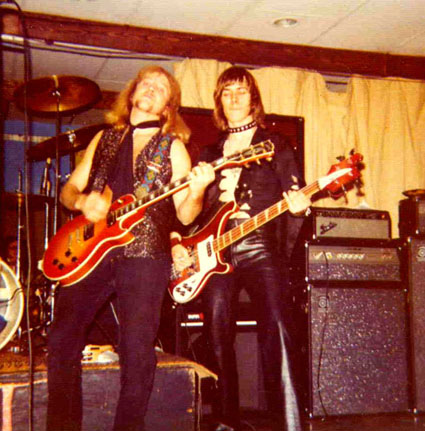 |
All of these songs were played at faster tempos than the originals. There
were bands that played arrangements of songs that other local bands did, but
we didn’t. We always felt that we were something more than a local band. We either played the songs like the record or evolved our own versions. We also broadened the song list when we had to play five sets each night (from 9pm to 2am) and needed all the material we could get. <- Larry and Tom on stage circa 1975 |
Q: What was the process that lead to recording and
releasing the LP?
TOM: By 1976, Magi was already playing dances and headlining concerts all
over Northern Indiana and some in Southwest Michigan. We were very, very
popular in those areas, drawing big crowds everywhere we played. To this day
more people in Northern Indiana know Magi than The Long Ryders! Magi wanted
to "make it," to sign a contract with a major labels, go on tour
and become successful. We saw making a first LP as the logical first step
toward building an even larger following and getting a record contract. Most
of the songs on "Win or Lose" were already written by the time I
joined the band in 1975. There was one extra song, "Hard Times,"
that we recorded the basic track for, but didn't finish. Magi’s writing
process was that either Larry or Steve would have an idea for a new song,
play it on guitar, and the band would work it up while John would write the
lyrics. Neither Jerry nor I wrote songs for Magi, but we helped with the
arrangements. I'm not sure how we decided to make "Mama" the
B-side of the Win or Lose 45 and leave it off of the album, aside from LPs
only allowing a certain length of music per side, so we had to eliminate
something. Also, "Hard Times" was one of the oldest Magi songs, so
that may be why we never finished it. When we recorded the songs for the LP,
we played the rhythm tracks live, and then overdubbed the guitar solos and
vocals. None of us had much studio experience, aside from a demo Magi had
recorded about a year before, without me. The actual recording sessions were
the first week of August in 1976 at Uncle Dirty's Sound Machine Studios in
Kalamazoo, Michigan. Someone in the band had a price sheet for Uncle
Dirty's, which advertised 40 hours of recording time, 1000 LPs and 1000 45s
for $1000, so we used money made from gigs to finance the recording.
Q:
Uncle Dirty's is known today for recording several obscure mid-70s bands.
What were your impressions of it?
TOM: Uncle Dirty's Sound Machine Studios was an 8 and 16-track recording
studio above ProCo Sound. The building where the studio and ProCo was has
been torn down recently. ProCo is still in business (their best-known
product is probably "The Rat," a popular distortion pedal for
guitars) but I think the recording studio closed down for good in the early
80s. The studio was operated by Bryce Roberson (correct spelling), nicknamed
"Uncle Dirty." Bryce had a history as a session guitarist with
Chess, playing and recording with tons of artists like Howlin’ Wolf,
Rotary Connection and possibly Aorta (as engineer?). Sadly, Bryce was not a
pleasant guy for us to work with. His attitude made our first “real”
recording experience a living hell due to his condescending, bitter
personality. He called our songs "epics" and once, when I screwed
up a bass part and asked, "Can you punch me in?" he replied,
"I'll punch you OUT!" That type of exchange was chronic.
Sometimes, people this surly can actually be fun to work with if they have a
sense of humor, but not Bryce. He was surly and serious. Kalamazoo was
an hour north of where we lived, so we drove back and forth each day. We
recorded in 8-hour shifts each day starting Monday, and I think that Friday
we did the final mix. I remember coming into the studio that Saturday for
some reason, seeing Bryce recording a band called Chopper, and hearing him
shout compliments to them through the talkback microphone on his console. It
made me think that maybe he just hated us. Bryce let me take home a reel
of rough mixes on Wednesday that I transferred to cassette, and
recently to CD. He wanted me to give back the reel of tape he loaned me,
probably so he could record over it again. I heard that Bryce recycled all
of his tape, including the 1 or 2-inch tape he used on his multitrack
recorder, using it over and over on sessions, rather than using new tape for
each client.
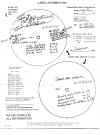
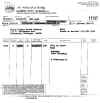
Label
design info & pressing plant receipt (clickable images)
According
to Debbie Stephenson, a ProCo employee of 30+ years, Bryce married a woman
named Ginger, moved to Detroit, and died about 15 years ago. The
LPs and 45s were pressed at Queen City Album in Cincinnati, Ohio. They’re
still in business as QCA. I called them a couple of years ago, in
search of the Magi master reel or any info. They told me that the master
reels were shipped back with the records. A very nice woman at QCA found
receipts for the pressing job in 1976 and recently mailed me eight
pages of photocopies. Steve Vanlaningham may have the master tape. No one
else claims to have it.
Q: The front cover is a bit of a classic with its
archetypal mid-70s look...
TOM: The cover was shot at a photography studio called Tom Photo. Those were
the clothes we wore onstage at that time. I remember the photographer called
me "Batman." Pretty hilarious looking now, but hey, we got laid a
lot back then.
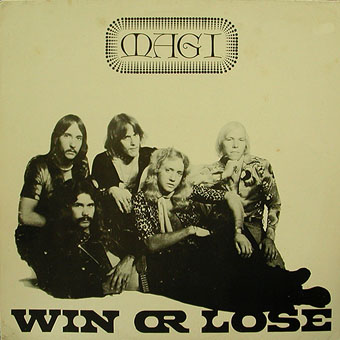
Q: Could you connect the photo of the band members on
the front cover with their names?
TOM: From left to right: Jerry Wiggins - drums; John Gaut
- vocals (lying on floor); Tom Stevens - bass, backing vocals; Larry Stutzman
- lead guitar, backing vocals; Steve Vanlaningham - lead guitar.
Q: After the LP was completed, were you satisfied with
it? What type of comments did you get? Were there any promo copies made and
distributed?
TOM: We weren't real happy with the final recording. The guitars didn't
sound as powerful as they did live. Larry and Steve were playing loud
through Ampeg V2 amps, but somehow the recording didn't capture their true
sound - it was much more sterile. There's a demo recorded with 2 condenser
mics and a Sony TC152SD cassette recorder during rehearsal the year before
that sounds exactly like we did live at that time. Still, we figured it
would help our career, and it did. Most of our fans agreed that it wasn't
the best possible representation of us, but they all were just really happy
that we had a record out. I think there was at least one white label test
pressing, but I don't know what happened to it, and we never marked any
records as promotional copies, although I saw some with the corners cut
somewhere. No major distribution was involved. Larry and I worked for a
music store whose owner also had a record store in the Pierre Moran Mall in
Elkhart called The Suspended Chord, and we sold lots of records there. We
also sold them at gigs, and "Snowbound" got quite a bit of play on
WRBR, the "album-oriented" rock FM station in nearby South Bend,
Indiana, where Notre Dame University is. All 1000 LPs and 45s sold out
within about a year.
Q: Was there any advertising or promotion
of the "Win or Lose" LP? Did you ever appear on
TV?
TOM: We bought radio spots on WRBR-FM in South Bend, Indiana, the only
rock FM station in the area back then, who played our song
"Snowbound." The first radio spots mispronounced our name – we
pronounced it Mah-geye (sounds like "cat eye"), but the
announcer called us “May-geye.” We also bought ads in the River City
Review, a small rock-music based free paper that came out of South Bend. We
were on local TV twice, in 1977 and 1978 on a Saturday afternoon
student-produced show on the Elkhart, Indiana ABC-TV network affiliate,
WSJV. Both appearances were lip-syncs. I think Larry also has some 8mm
silent footage of the band on the road.
Q: After the LP was out, what did Magi do? Was it
business as usual in Indiana?
TOM: Most of our gigs were in Michigan bars by 1977, with a few in Indiana
and Illinois. The high school dance gigs were dying off. We all quit our day
jobs for a while and played six nights a week, five hours each night. Cities
in Michigan included Muskegon, Midland and Alpena. This went on for a year
or more. Our booking agent was called Siddhartha, based in Lansing, MI.
There was enough work for us, but the top dollar was still made by the Top
40 bands, rather than hard rock bands like ourselves.
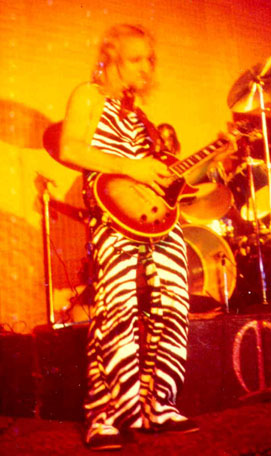
"Ah
yes, Larry's leopard suit. The
chicks went wild over that. Seriously."
Q: I understand the band moved to Los Angeles in the
late 1970s -- could you describe the events and thoughts that led to this
decision? Did you have something specific lined up there?
TOM: We moved to Los Angeles in March-April of 1979. Some factors that
led to this decision were:
- Drinking age in Michigan went to 21. On January 1, 1972, the drinking age
in Michigan was lowered from 21 to 18. The big argument in favor of lowering
the age in 1972 was that young soldiers returning home from Vietnam should
be trusted with alcohol, and laws were passed. As a result, business in bars
in Michigan boomed, and bands had many, many gigs there to play.
That all changed on December 3, 1978 when the drinking age went back to 21
as a result of teenage carnage on the highways (I saw that myself) and
reported drinking problems in high schools. Suddenly clubs were closing or
only having bands on weekends, so the amount of gigs in the area
plummeted.
- Indiana/Michigan area weather sucks. The winter of 1976-1977 was bad
enough, lots of paralyzing snow, and the next winter was even worse. We were
playing for a week in Rockford, Illinois in late January of 1978, and the
snow was so bad in Indiana that we were stranded in Illinois for an extra
day. Also, during the thaw that spring, our practice barn flooded then froze
solid. We went to rehearse and found our amps frozen to the floor under a
few inches of ice. We took it as one of many signs that it was time to
move out of Indiana.
- The area was limited. By 1979 we had pretty much hit the limit of our
popularity in the area. Unlike the 1960s, when The Rivieras from South
Bend/Elkhart or Tommy James from Niles, Michigan (just above South Bend,
Indiana) could make a record on a low budget and have it become a
national hit, in the late 1970s “making it” the rock business
seemed to mean that we had to relocate to where the music industry was.
Opportunity: Larry Stutzman’s uncle, Danny Lee, was then a successful
songwriter/gospel artist living in Los Angeles. Larry got in touch with him
sometime in late 1978 about moving Magi to California, and Danny said that
he would help us. Larry then started talking to all of us about it. We had
earlier considered moving to Florida since there was plenty of work in bars
there and the weather was nicer than Indiana, Our booking agent Siddhartha
also offered us a lengthy gig in Alaska. We stopped talking about Florida
and Alaska once Los Angeles started being discussed.
Sadly, Steve Vanlaningham announced to us that he would not be moving with
us. He was already married with a child and had another on the way, and
preferred to stay behind in Indiana. He’s a fine guitarist and great,
quiet, down-to-earth guy. We chose as his replacement Greg Miller from
Syracuse, Indiana (home of The Tikis) who came from a similar background as
us – he was in a band called Sky before joining us, and probably others.
After the band broke up, Greg, Larry and I recorded over 100 country songs
on Larry’s 4-track reel-to-reel recorder. Plans to move to L.A. were
fairly set by Christmas of 1978. We were playing a small bar near Milford,
Indiana called Stony Ridge on December 28-29, 1978, packing the place each
night, and I remember my old girlfriend asking me about our upcoming move to
California, something that she somehow already knew about. Larry’s uncle
Danny helped set us up with a 3-bedroom condo on Silver Lake Blvd. in East
Hollywood, across the street from a club that’s now called Spaceland,
which was a Korean disco back then. By April, 1979, we had all moved
to Los Angeles. We had no specific plans, no gigs lined up, nothing. We
just got in our cars and made the 51-hour drive to our condo, armed
with press kits and our equipment all packed into a Chevy C-60 truck, and
planned from there.
Q: How did the music scene in Los Angeles seem to you
then -- was it different from what the band had expected?
TOM: It was much different from what we’d expected. We arrived in L.A.
just in time to find that the style of music we played was completely out of
fashion. The punk scene (The Germs, X, Black Flag) was huge there at the
time and affected every aspect of live rock music in L.A. clubs that drew
crowds or got press coverage. The type of hard rock we played was dead in
L.A. in 1979. It was still popular (and will always be) in blue-collar
Indiana, but it would be about 8-9 years before it was big again in Los
Angeles. We tried to adapt. By then we had a manager, Don Straka, who had
worked as a regional rep for Columbia and been with us for a year or so. He
co-wrote one of our later songs, “Lovegood Street”, sat in on rehearsals
giving us tips, and also sat in the control booth when we recorded our 1978
demos. He said he had plans and moved to California with us. After one gig
in Costa Mesa and another at Gazzari's on the Sunset Strip in West
Hollywood, we changed our name to The Charge, wrote a few new songs closer
to an 80s new wave style, and played two more gigs, one at Club 88
in West L.A. and one more Gazzari's. The move to L.A. and the changes
just didn’t work for the band. We didn’t come to L.A. with enough
money to sustain ourselves for long, so we all got day jobs. I started
working at Tower Records on the Sunset Strip and Larry at Music Plus, a
record store on Vine Street in Hollywood. John found work building trailers
as he did in Indiana, and Greg worked for a dry cleaner. We were too busy
trying to make money to pay rent to put in the time it takes to make a name
in Hollywood, and Don Straka was ineffective at getting any kind of music
industry interest.
Also, in addition to the five of us in the three-bedroom condo, the band
members and crew started moving their girlfriends in, and even kids. I
think our max was 17 people staying there at one time. People would
then move out, sometimes leaving us to pay their enormous phone bills. Jerry
Wiggins, the drummer, moved back to Indiana first. We got Keith Cripe (from
Indiana) on drums for the last gig or two, but he never fit in due to his
personality. At the last gig at Gazzari’s, John (the singer) was sick and
gave up trying to sing, and we all tried to fill in just to get through the
gig. It felt like a disaster. Shortly after, John and finally Keith moved
out. Only Larry, Greg and I were left, and we all got separate places
in various parts of L.A. That was the end of the band. I
started seriously writing songs soon after I moved to L.A. The earliest
recordings worth mentioning were “The Grip” and “Telephone” in
December, 1981 that wound up my "Points Revisited" CD.
Q: Could you say something about the process and work
behind the "Points of view" mini-LP?
TOM: As Magi was fading, I realized that I had to start writing
and singing a lot more. I did look around for bands and session work in
L.A., but I found lots of bands, but none that I felt were worth my time.
Probably the most well-known band I auditioned for was The Rubinoos (on the
Berserkley label at that time), but I couldn’t sing high enough to fill
that position. The only session work I found was for some disco singer that
was doing an update on “Sealed with a Kiss.” I may actually have a tape
of that still, and it’s really awful. As Magi splintered, everyone
moved out of the condo in Silver Lake into our own apartments, or else home
to Indiana. I found a beach house 9 blocks from the Pacific Ocean in Santa
Monica. Shortly after I moved there my car got wrecked, the car I bought to
replace it died after a few months, so I was without a car. I would take two
buses every day to work at Tower Records, and then back home. I didn’t
have much money at all. I lived alone and didn’t even have a TV, but I did
have a guitar and tape recorder, so I started writing constantly. Most of
the songs weren’t great, but a few good ones would start popping up as I
wrote more. At that time I was listening to a lot of Buddy Holly, Bobby
Fuller, Beatles and Big Star, so the songs reflected that. I wanted to do
something completely different from Magi. When I had written enough
decent songs to play, I started looking for live solo acoustic gigs. My
first show was at the Troubadour in West Hollywood on December 8, 1980, the
night John Lennon died. I think I was the only one in the room that didn’t
know. It was ironic, too, that that was the same room that Lennon came out of the
bathroom with a Kotex pasted on his forehead, and the classic
Lennon-to-waitress exchange took place: "Don't you know who I am?"
"Yeah, you're some asshole with a Kotex on his head.” A
co-worker at Tower, Sunny Paul, had a four-track TEAC tape recorder at his
house, and by late 1981 I was able to record some songs there. "The
Grip" and "Telephone" on Points Revisited were from those
sessions, with Sunny on drums and me on everything else. I took that tape
and made about 50 copies of it, and passed it around to anyone I knew would
listen that could possibly lead me to a record deal.
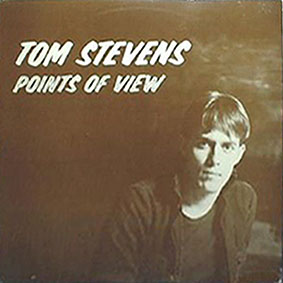
Some other co-workers, Matt and Mark Humphries, had a label called Pulse and
were doing pretty well with an EP by an L.A. band called Middle Class. They
liked my tape and decided to record me as well. I formed a band for the
recordings quickly. Drummer Mark Cuff was in The Textones, Carla Olsen’s
band. I knew her very well from her frequent visits to Tower, and later
played standup bass with Carla and Gene Clark (from the Byrds) for a couple
of live shows in L.A. The bassist was Johnny Bethesda, from the
Akron-via-L.A. punk band The Rubber City Rebels. They’d had an L.A. radio
hit with the indie 45 “Young and Dumb.” The recording was at
Perspective Studios in Sun Valley on September 29, 1982. We recorded all six
songs in about 5 hours or so. They were all songs I’d demoed before, and
the band was rehearsed and ready. Thom Wilson engineered those sessions –
Thom later got his fame from producing the band Offspring’s hits. We
mixed the EP at Gold Star in Hollywood with Stan Ross, one of the owners and
guys that were there during Gold Star’s golden years of Phil Spector,
before they tore down the original studio in the 90s. It was a good idea,
but Stan hadn’t a clue what to do with my music. It was deliberately spare
with one guitar, bass, drums and voice, and I think that drove Stan nuts. He
kept saying that we should have let him record it, and he did a
fast-as-possible, assembly-line job on it, in about two hours flat. The
mastering was even worse, another budget, rush job. I didn’t like the
cover – the photos were nice enough, but I hated the font and the brown
tint. But, I didn’t feel any power over anything to do with that project
except playing my songs. The EP did OK and sold its 1000 pressing in a
couple of years, and got decent reviews. The label owners were very keen on
having Rodney Bingenheimer give it a good push on his KROQ radio show, but
Rodney said it was a folk album and declined to play it – Rodney was
playing hard-core punk at the time. I think the label though this would be a
big cash cow for them, and it wasn’t, although it did sell steadily. Mark
and Matt later disappeared and no one knows what happened to them.
Q: What do you think of the mini-LP today?
TOM: I listened to "Points of View" a few weeks ago, and while I
thought it was a good start of trying to make a completely different style
for myself, I thought the production was weak (I’m credited, but I really
had no control) and the mastering was terrible. Still, there was and is a
demand for that record. While on tour with The Long Ryders in Europe,
several people brought "Points of View" EPs for me to sign. After
my solo CD "Another Room" came out, people were writing to the
label asking for a "Points of View" reissue. I instead put out
"Points Revisited", which contained some Points of View tracks,
but substituted demos for some other PoV tracks that I thought told the
story better. Also, a Swedish label, Sound Asleep, put "Just One Night
with You" on their Home Runs v.2 comp CD a year or two ago. So, like
with "Win or Lose", a record that was not up to personal
expectations wound up with a lot of fans and definitely did not hurt the
career.
Q: How exactly did you wind up in the Long
Ryders?
TOM: It was just before Christmas in 1983. I’d left my day job at Tower
for another job at Sounds Good Imports, which operated in the same building
as Rhino Records. I knew the Rhino guys from my Tower days, and had some
interesting co-workers like Joe Nolte from The Last. Another co-worker, John
Aynes, brought a pre-release cassette of his old roommate’s band, which
was "10-5-60" by The Long Ryders, and played it a lot while we
were working. I was impressed with that EP and wound up buying it. Later,
around Christmas time, John and Joe and probably others were standing around
talking. The night before, I was recording country songs with ex-Magi member
Greg Miller on Larry Stutzman’s 4-track. We tended to drink a lot of beer
(Budweiser in a bottle) during those sessions, so I was no doubt a bit hung
over. John was telling the story of how The Long Ryders had just fired their
bass player, their third. Without missing a beat, I said, “hell, I’ll
play bass for them!” I almost felt it an absurd statement, but being hung
over I didn’t censor myself. The next thing I knew, both John Aynes and
Gary Stewart (an old friend from Tower who is still has an important
position at Rhino Records) were on the phone to Sid Griffin, saying “you’ve
got to get this guy.” I didn’t even have to formally audition. The
Long Ryders had gigs coming up in the San Francisco area and needed someone
quickly. They also knew that if they were to grow their careers, they would
have to go on the road, and I already had experience in that from the Magi
days, and was ready to go. The recommendations from several mutual friends
didn’t hurt, either. During that same time, I found out my future
wife was pregnant with my daughter, and we got married New Year’s Eve,
1983. When Sid found out in January, he said, “I thought you said you
weren’t married!” I told the truth; I wasn’t married during our first
conversation, but got married just before our first gigs. Christmas-time of
1983 was when I quit my day-job, got married and found out my first child
was on the way, all in the same week. The rest is history and The Long
Ryders traveled the world for the next 3-1/2 years, until I left after a
particularly disastrous European tour in 1987, and Stephen McCarthy left
after the ill-advised, disastrous U.S. tour without me that immediately
followed it.
Looking
for Peter Lewis and Gene Clark - the classic
mid-1980s Long Ryders line-up with Mr Stevens upfront.
Q: You joined the Long Ryders around the time when
they were going from a clear 60s-retro style (as on their first mini-LP)
into a more timeless rock'n'roll style. Was this a transition in process
when you joined, or was it already in place?
TOM: Sid formed The Long Ryders after leaving The Unclaimed, which was about
as self-consciously 60s-retro a band as you can get, so a bit of that was
bound to hang on into the new band. Stephen McCarthy brought with him his
60s roots as well, but also a very well-defined Bakersfield country guitar
and vocal style – listen to "You Don’t Know What’s Right"
from "10-5-60" for a good example. From the start The Long Ryders
were all about hybrids of pure American styles of music, as mostly defined
by 60s bands, both rock and country. That all distilled through skilled
songwriting into more of the classic style that you hear on "Native
Sons". Probably half to two-thirds of the songs on "Native Sons"
were already written by the time I joined, but I got in just in time to
write the words and melody to "Wreck of the 809", for which
Stephen already had the chords, and "Too Close to the Light"’s
“taught us how the wrong could be right” part. I think at that time The
Long Ryders were at the very height of their songwriting powers, and ability
to naturally hybrid cool styles into a single form. In the later stages the
band became a great live act, but drifted a bit from that original, natural
hybriding ability, but still managed to have some good songs on each album.
END
OF INTERVIEW
MAGI EPILOGUE: "Larry Stutzman was the
last Magi member to leave L.A., in 1989. He'd been recording dozens of
mostly keyboard-oriented original songs by himself.
He also managed Music Plus on Vine Street in Hollywood, then quit
his position and made the Tuff City LP around 1988 on his own Hoosier
Records. He also ran a recording studio in a converted garage at his house
in Granada Hills called Larry’s Pro Sound and recorded many L.A. groups,
including what later became the band System of a Down. In about 1990, Larry
and I were briefly in a bar band in Indiana called The Generators that only
lasted about 2-3 months. Some band members scammed him and stole a bunch of
musical equipment from his house, then left town. John Gaut and Jerry
Wiggins were both in a country band called Grand Army Highway in the 1990s
and released a CD that included a cover of Magi’s “Snowbound.” They
have since broken up. Steve Vanlaningham still lives with his family in
Milford, Indiana. Greg Miller stayed in Burbank, California until early
1985. He originally was going to move to Indiana, but went to visit his
brother in Florida and has lived there ever since. He was living in
Englewood, Florida the last I heard from him in the mid-90s, playing guitar,
pedal steel and banjo in a bar band. The five Magi members on the "Win
or Lose" LP played a reunion gig on August 27, 1994 at the Elkhart
County (Indiana) Fairgrounds. To date that was the last time all five of us
have played together."
MAGI
RECORDINGS
1973
"Jarvis Brothers" demo
1. Snowbound
2. Undecided Man
3. Walkin' the Dog
4. Hard Times
Tracks 1 & 2 were recorded again for the Magi LP in 1976. This 1973 demo has an appealing embryonic feel, although much of what would be the Magi sound is already in place, and the sound is tight and rocking. "Hard Times" is a typical boogie hardrocker with excellent guitarwork."The Jarvis Brothers demo was with Larry Hertzler on bass, before I joined the band. You can tell the early Aerosmith influence with the "Walkin' the Dog" arrangement being lifted from Aerosmith's 1st LP. But then, " Undecided Man" is another story - that lead (and the one in "I Didn't Ask You") was played by Steve Vanlaningham, who had this great John Cipollina-like lead guitar style, which contrasted Larry leads nicely. One of the Jarvis Brothers is Dale, who played bass for some label country acts including Lionel Cartwright." - Tom Stevens
Summer 1975 rehearsal tape
1. Lord of the Thighs (ending only)
2. Win or Lose
3. Everytime I'm With You
4. I Didn't Ask You
According to Tom Stevens this rehearsal tape from drummer Jerry Wiggins' house in Wakarusa is a good approximation of the band's live sound, and in Tom's opinion better than the "Win or Lose" LP. After hearing it I have to agree; the band is as tight as ever but there is a rawness and expansive energy that make the familiar tracks (2, 3 & 4 are all on the LP) sound different and very powerful.
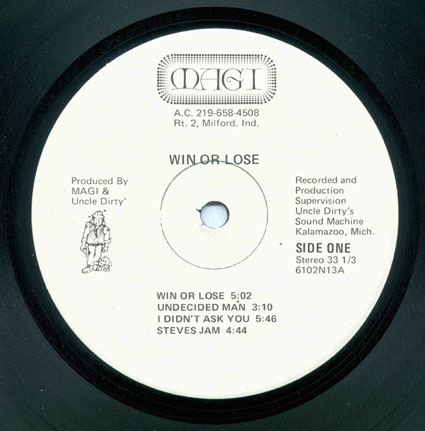
July 1976 "Win Or Lose" LP sessions at Uncle Dirty's studio in Kalamazoo, MI
1. Win or Lose
2. Undecided Man
3. I Didn't Ask You
4. Steve's Jam
5. Fryin' Away Time
6. Runnin' Low
7. Snowbound
8. Everytime I'm With You
9. Mama
10. Hard Times (not finished)
Tracks 1-8 constitute the "Win or Lose" album, while "Mama" came out only as a non-LP 45 track. It's very similar in style. For details around the recording session, see the interview above. The master tapes are currently lost, while a tape of rough mixes exist."A Bryce Roberson mix signature would be the fade out in Undecided Man, or reverb in Fryin' Away Time. The rough mix cassette also has an interesting pan effect on the guitars in I Didn't Ask You that he didn't do that on the LP mix. I also remember Bryce putting TONS of duct tape on each drum and cymbal for that "special" 70s drum sound. Funny how he loved reverb, echo and panning, yet his background was with Chess R&B and jazz." - Tom Stevens
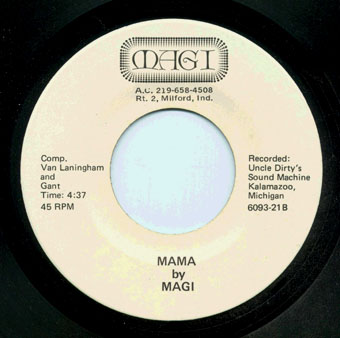
February 1978 demos
1. Over On Us
2. Without You
3. Wrong Kind of People
4. Lonely Lady
5. Lovegood Street
Excellent material, none of it on "Win or Lose". The typical Magi hardrock style is present but the songs take a wider grasp with good results. The band has a clear identity, a professional sound and no weak points -- like Tom says below this deserved to give Magi another chance at a record release."These songs were recorded February 16, 1978 at the Underground Studios in Indianapolis. It was in the basement of some Christian guy's house. Kirk Butler engineered, we produced. Kirk later moved to L.A. All the songs were recorded pretty much live. I remember the date because we stayed the night before in a motel and watched the Muhammad Ali vs. Leon Spinks fight on TV, since the session was very early in the morning. The entire session was only a few hours including mix. Sad that those tracks were never released, and no master tape exists - this was transferred from a 2nd generation cassette!"
DISCOGRAPHY
LP "Win Or
Lose" (no label 6102N13, 1976)
-- 1000 copies pressed by the band.
45 Win Or Lose / Mama (no label 6093-21B, 1976)
-- 1000 copies pressed by the band. B-side appears on this 45 only.
Posthumous
"Win
Or Lose" LP bootleg on the Breeder label from Austria, c1987
-- exact repro except for the label design and "Breeder" added
to front and back cover. Sound quality on this vinyl-sourced boot is pretty
good and close to the original. Hard to find nowadays.
"Win Or Lose" CD bootleg on the Flash label from Italy, early
1990s
-- this is possibly from the same source as the Breeder bootleg, or at
least sourced from the Breeder LP rather than an original. As Tom reports
below, the sound quality isn't impressive.
"Bootlegging doesn't bother me a whole lot - Win or Lose has been bootlegged at least twice on Breeder and Flash. I bought both, and listened to the Flash CD and it was terrible - someone used a noise-reduction system with very bad results. The Long Ryders have been bootlegged as well - we'd play a Tuesday show in London and by Saturday tapes would appear at Camden Town. I'd imagine the reunion may have it's share of tapers, too, and I'll do nothing to discourage it. I've thought seriously about doing a reissue of the Magi stuff. Last I mentioned it the guys were still obsessing over the master tapes, which may never be found. Still, I'd like to have a go before someone else puts out another bad-sounding reissue." - Tom Stevens
Related
TOM
STEVENS: "Points Of View" mini-LP (Pulse PR234
6-song 12" EP, 1983)
-- 1000 copies pressed
-- tracks: Telephone - Just One Night With You - 24 Hours - The Grip - Friend Or
Foe? - Another Man's World
Tom
Stevens has released a few more items after the Long Ryders era, including a
retrospective CD with material from the early 1980s. Details on this, the
Ryders, and much more can be found at Tom's website.